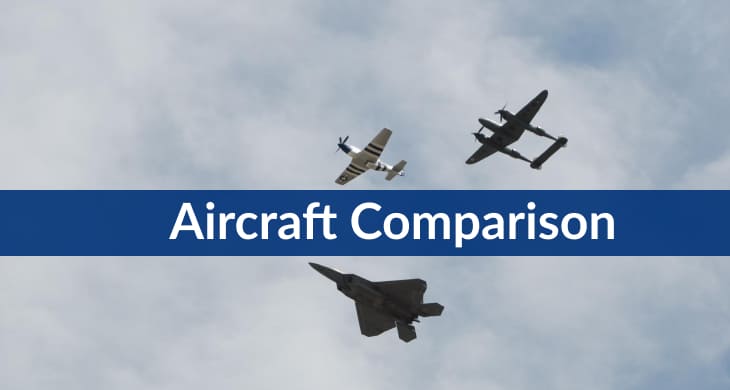There is no doubt that Sukhoi jets are some of the best in the world. But with two unique models to choose from, which is the best? This blog post will compare and contrast the Sukhoi Su-27 and Su-35 to help you decide which is right for you!
| Aircraft: | Sukhoi Su-27 “Flanker” | Sukhoi Su-35 |
|---|---|---|
| Photo: |
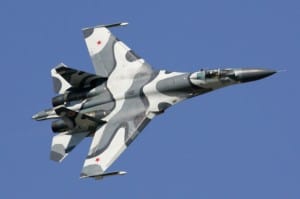 |
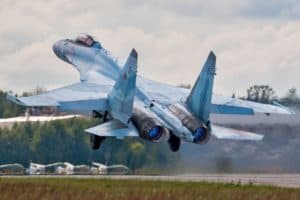 |
| Country: | Russia | Russia |
| Manufactured: | from: 1985 to: Present | from: 1995 to: Present |
| ICAO: | SU27 | SU35 |
| Price: | $37 million | $85 million |
| Avionics: | Sukhoi Search and Track Radar / Fire Control, OEPS-27 IRST, OEPS-27 electro-optical targeting system | Su-35 cockpit instrumentation suite MFI type, Irbis-E passive electronically scanned array rada |
| Engine: | 2x 2 × Saturn/Lyulka AL-31F turbofans | 2x Saturn AL-41F1S afterburning turbofan |
| Engine Type: | Turbofan | Turbofan |
| Power: | 27,600 pound-force | 32,000 pound-force |
| Max Cruise Speed: |
1546 knots 2,863 Km/h |
1458 knots 2,700 Km/h |
| Approach Speed (Vref): | 129 knots | - |
| Travel Range: |
1,906 Nautical Miles
3,530 Kilometers |
2,400 Nautical Miles
4,445 Kilometers |
| Fuel Economy: |
0.62 nautical mile / gallon 0.303 kilometres / litre |
0.44 nautical mile / gallon 0.215 kilometres / litre |
| Service Ceiling: | 62,000 feet | 60,000 feet |
| Rate of Climb: |
54000 feet / minute 274.32metre / second |
55000 feet / minute 279.40metre / second |
| Take Off Distance: |
450 metre 1,476.36 feet |
550 metre 1,804.44 feet |
| Landing Distance: |
620 metre 2,034.10 feet |
670 metre 2,198.14 feet |
| Max Take Off Weight: |
30,450 Kg 67,130 lbs |
34,500 Kg 76,059 lbs |
| Max Landing Weight: |
21,000 Kg 46,297 lbs |
- |
| Max Payload: |
4,500 Kg 9,921 lbs |
8,000 Kg 17,637 lbs |
| Fuel Tank Capacity: |
3,080 gallon 11,659 litre |
4,410 gallon 16,694 litre |
| Baggage Volume: | - | - |
| Seats - Economy: | 1 seats | 1 seats |
| Seats - Business Class: | 1 seats | - |
| Seats - First Class: | - | - |
| Cabin Height: | - | - |
| Cabin Width: | - | - |
| Cabin Length: | - | - |
| Exterior Length: |
21.9 metre 71.85 feet |
21.9 metre 71.85 feet |
| Tail Height: | 5.92 metre - 19.42 feet | 5.9 metre - 19.36 feet |
| Fuselage Diameter: | - | - |
| Wing Span / Rotor Diameter: |
14.7 metre 48.23 feet |
15.3 metre 50.20 feet |
| Wing Tips: | No Winglets | No Winglets |
| More Info: | Sukhoi Su-27 “Flanker” | Sukhoi Su-35 |
|
Data presented is for entertainment purposes and should not be used operationally.
|
Other Sukhoi Su-27 “Flanker” comparisons:
- Su-27 vs F-22
- Su-27 vs F-35
- Su-27 vs F-16
- Su-27 Flanker vs F/A-18 Super Hornet
- Sukhoi Su-27 vs Lockheed Martin F-22 Raptor
Other Sukhoi Su-35 comparisons:
The Sukhoi Su-27
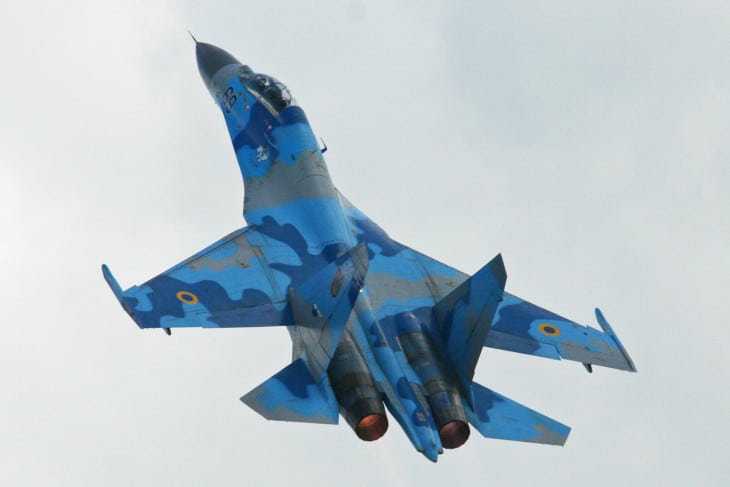
In the early 1980s, the Soviet Union desired a multirole fighter jet that could be used across multiple branches of their armed forces. The Sukhoi Su-27 was designed and built with this mission in mind:
To provide air superiority; perform tactical air defense operations like close-air support and convoy escort; perform reconnaissance and shuttle missions; facilitate refueling of other aircraft in flight, and act as an aerial command post.
Additionally, it needed increased maneuverability due to its advanced engines, a powerful weaponry system including both short and long-range missiles, and all-weather construction for use in different conditions.
As a result of this build spec, the Sukhoi Su-27 became one of the most successful fighters produced during the Cold War and still serves its mission today – with modern upgrades – around the world.
The Sukhoi Su-35
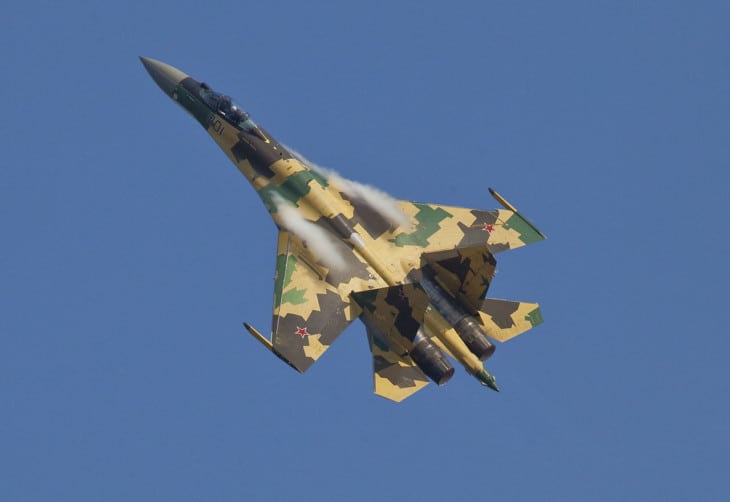
The Su-35 is a modernization of the existing Russian-designed Su-27 fighter jet. The aircraft was designed to enhance the capability of both its combat performance and operational effectiveness.
The Soviet Air Force initially requested its creation to meet their demands for an all-weather multirole fighter with increased capabilities and improved air defense capabilities.
Su-35 underwent advanced testing and upgrades in performance, avionics, and usage before being admitted into service by the Russian Aerospace Force in 2008.
Today, Su-35 is a frontline fighter capable of supporting ground forces, patrolling airspace, and defending against hostile targets during aerial combat scenarios.
The improved platform also offers more excellent range with expanded capabilities such as enhanced low observable technology, powerful radar capabilities, electronic intelligence gathering, better maneuverability, and high endurance capacity.
Its modern design allows it to effectively engage enemies from land or air while improving safety for pilots during operational missions.
Differences between the Sukhoi Su-27 and The Sukhoi Su-35
The Sukhoi Su-27 and the Sukhoi Su-35 are two Russian fighters in the same family but with significant differences in performance and capability.
Although both feature advanced avionics, the Su-27 has a less powerful engine. It is also downgraded from its export version, which includes fly-by-wire technology.
The Su-35 has been given some comprehensive modernizing upgrades over its ancestor. It features advanced thrust-vectoring engines for increased maneuverability, an improved avionics suite, and a passive electronically scanned array radar system.
Additionally, the aircraft possesses a drastically reduced infrared signature due to the use of advanced material used in the manufacturing design process compared to its predecessor.
Regarding weapons capability, the Su-35 carries advanced missiles like the Kh-59MK2 and glass cockpit features that make pilots more comfortable while flying them at low altitudes. It is undoubtedly one of the most formidable fighter jets of all time.
Similarities between the Sukhoi Su-27 and The Sukhoi Su-35
The Sukhoi Su-27 and the Sukhoi Su-35 are contemporary, fourth-generation fighter jets from Russia. While they are similar in many regards, the most prominent similarity between them lies in their sleek, streamlined design, which is incredibly aerodynamic.
Both aircraft have an impressive array of weapons systems, sensors, and electronic warfare tools. They also share multiple standard structural features ranging from the engine bays to the Nose Landing Gears.
Additionally, both aircraft incorporates an advanced fly-by-wire system that provides pilots numerous advantages. Fuel efficiency is another aspect where the two jets show a great deal of similarity due to the use of specialized control software for enhanced thrust vectoring capabilities and improved efficiency ratios.
When it comes to performance, both aircraft possess exceptional maneuverability capabilities thanks to their thrust-vectoring engines and their high levels of thrust-to-weight ratios.
As such, each craft can easily handle demanding maneuvers while showcasing remarkable agility when faced with unexpected dog fights or evasions.
It’s easy to see why these two supersonic jets remain famous for air forces worldwide looking for reliable warbirds that provide outstanding operational performance across recon, interceptor, and combat roles alike!
What’s better about the Sukhoi Su-27
Here are the four better things about the Su-27:
Super Sonic Speed:
Its uses range far beyond that. It can perform complex aerobatics such as the ‘Cobra’ and ‘Bell’ maneuvers while flying at twice the speed of sound. The Sukhoi Su-27 has superb agility coupled with top-speed performance.
Highly Maneuverable:
Its maneuverability can make it very difficult for an enemy to track or target it effectively. Yet another impressive feature of this plane is its long-time endurance capabilities- it can remain airborne for up to 3 hours uninterrupted.
Advanced Avionics:
The Sukhoi Su-27 boasts a significantly advanced avionics package, making them suitable for mission role adaptation. Ultimately the Sukhoi Su-27 is one of the most intimidating aircraft in the world.
Highly efficient:
With its highly aerodynamic design, the airframe has minimal drag and can fly longer distances than other fighters making it a truly powerful aircraft.
What’s better about the Sukhoi Su-35
Here are the four better things about the Su-35:
Highly Maneuverable:
With a thrust-to-weight ratio of 1.3, it is hugely air maneuverable, capable of outclassing the performance of fourth-generation fighters, even those from rival nations.
Heavily armed:
It is equipped with the latest avionics suite. It boasts up to 9 surface-to-air missiles and 7 air-to-ground missiles simultaneously.
Advanced radar system:
Its advanced radar system has a range of over 400 km, making it ideal for mission-critical activities like an early warning and long-range reconnaissance.
Advanced technology:
Its electronic warfare suite allows for jamming and interception capabilities and enhanced information-gathering opportunities.
Conclusion
Overall, both the Sukhoi Su-27 and Sukhoi Su-35 are mighty machines. While they share many similarities, each has unique features that make them ideal for different mission roles.
The Sukhoi Su-27 is known for its speed and aerobatic capabilities. At the same time, the Sukhoi Su-35 is renowned for its long-range and heavy weapons load. Ultimately, the choice between these two fighters depends on the type of mission that needs to be completed.
No matter which one you choose, you can rest assured knowing that you have a powerful machine at your disposal!
